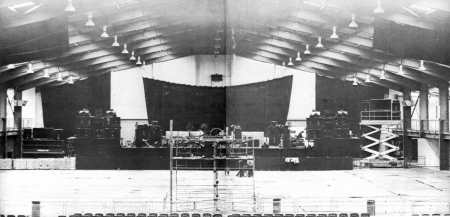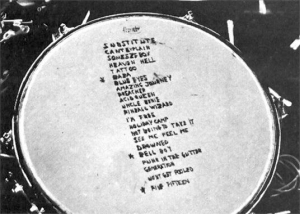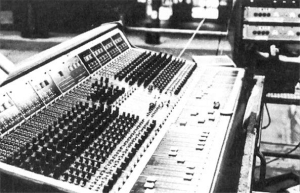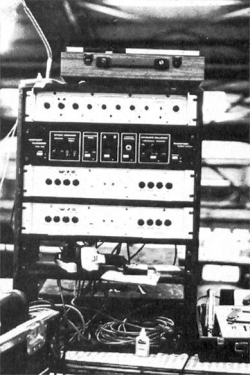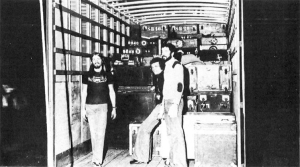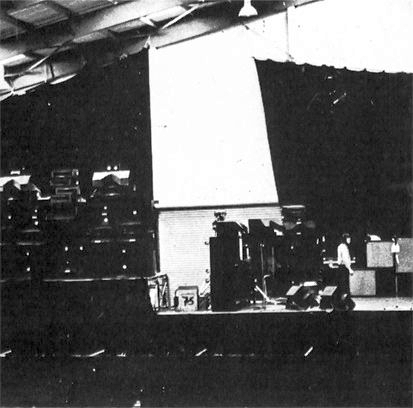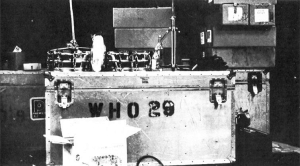International Musician and Recording World: On Tour With The Who’s Road Crew, December 1975
International Musician and Recording World: On Tour With The Who’s Road Crew, published December 1975.
by Eamonn Percival
with MEH and the roadies of rock’s greatest band.
I.M.’s Eamonn Percival humps gear for the Best Band in the World
The new Bingley Hall, Staffordshire, was the place The Who chose to kick off their first British tour in nearly two years. Situated on the huge Staffordshire Agricultural Showground just off the Stafford-Uttoxeter Road, the hall is a giant 8,000 seater usually used for cattle shows, but ideal for a band like The Who and their massive Marshall Equipment Hire P.A. system.
The whole sound system was transported up to the gig with the road crew on Thursday night. Most of it was set up on Friday morning, the day of the first gig (The Who were to play two consecutive nights at Stafford). My journey began at Friday midday, when MEH’s Joe Brown, his wife Barbara, Ken Fleg, (the brains behind the Gelf desk which I’ll be detailing later) and I started out from MEH’s base in London’s Mile End Road. We arrived at Bingley Hall at three and a check was carried out to make sure everyone had done their jobs correctly. The mixing desks were set up on a scaffolding halfway down the hall and overlooking the stage, which was built to The Who’s road crew’s specification. The P.A. system, as usual, was set up on either side of the stage, with one section stacked on a scissor lift at either side, and raised to a height slightly above that of the P.A. stack.
By five o’clock, the Steve Gibbons Band had just about finished their soundcheck, and all was going well. Various members of MEH and The Who’s sound crew were scuttling round the hall, listening intently to the sound in the gigantic auditorium. Massive queues were forming outside, and their patience was rewarded at 7.50 when the doors opened. They were still pouring in by the time the Steve Gibbons Band came on stage, and they gave the band a rousing welcome.
Bob Pridden, the man who does The Who’s monitor mix, was busy behind his desk on the side of the stage, hidden between the P.A. stacks and the onstage monitors. As well as mixing the monitors for The Who, it was Bob’s job to handle the monitor mix for the Steve Gibbons Band for this tour.
Halfway through the Steve Gibbons Band’s set, Roger Daltrey strolled about backstage and eventually perched on an empty flight case at the side of the stage to listen to the band. They have recently been signed up to Daltrey’s Goldhawk label, hence Roger’s fatherly interest in them. The set finished at 9.00 p.m. and what seemed like hundreds of roadies immediately converged on the stage to remove the Gibbons Band’s equipment, replacing it with The Who’s.
Keith Moon uses so many mikes on his kit that a separate mixer had to be used to mix the Steve Gibbon’s drummer’s kit to avoid complications in setting up a different system of mikes. Entwistle’s and Townshend’s stacks and Moon’s gigantic kit were set up on risers behind the band with coloured lights underneath, so virtually all of the stage had to be rearranged before The Who came on.
Promoter Harvey Goldsmith appeared onstage for five minutes and tried to get everyone to sit down. Under the circumstances, he managed very well. The front half of the hall was thick with Who fans, virtually sitting on top of each other, while the back half of the hall was arranged into seats, although most people were standing on them.
At 9.30 p.m., Daltrey, Townshend, Entwistle and Moon ran onstage, completely destroying Goldsmith’s efforts to calm the crowd. Moon hammered the drums, Entwistle thumped out a bass line, Daltrey shouted “Hello”, and Townshend thrashed out the opening chords of “Substitute”. Coloured stage lights and glaring follow-spots burst into life, as did The Who. They followed with “Can’t Explain”, “Squeeze Box” and “Heaven And Hell” at what seemed like deafening volume from the front..
This is where the problem comes in for the sound crew. With each member of the band playing at such a high level, the vocals must still be able to cut through without feedback. Not only that, but the band need to hear what they’re singing through the monitors.
“Baba O’Reilly” followed and Bob Pridden was, by now, really working frantically. The number starts with a taped synthesizer played through two large monitor stacks behind the band, and Bob has to have the track already cued in before the end of the previous number. Moon wears headphones during the “tape” numbers, and the synthesizer track is cued in with a “click” on the tape which is fed through the cans, but switched out of the P.A.
Eight songs from “Tommy” followed, climaxing with the “listening to you” section of “See Me, Feel Me” at which point, five giant spotlights rose from the back of the stage trained on the audience. They carried on with “Drowned”, “Bell Boy” and “Punk” from the “Quadrophenia” set, and it was during “Drowned” that the first real problem arose. In the guitar intro, Townshend stopped playing, turned to Moon and shouted “I can’t hear, Keith!”. The number started again, and all went smoothly. “My Generation”, “Won’t Get Fooled Again” and “5.15” ended a superb set, and the band trooped off stage arm in arm to the dressing room.
The time was now 11.15, and the press and most of the road crew converged on the bar. As The Who were there for two nights, the gear was left onstage and the show was discussed in detail. The problem which arose during “Drowned” was tracked to the fact that the drums and guitar stacks were on the riser about a foot above stage level, so it was decided to remove the platform for the following night’s performance.
By midnight, the bar had closed and everybody left for the North Stafford Hotel. The hotel boasted 24-hour service, and so the staff were kept busy ferrying drinks in and out of the lounge, where various roadies, soundmen, and journalists sat around discussing the show. Daltrey and Entwistle were also there, laughing and joking with the road crew and wondering where Keith Moon had disappeared to. At 2 a.m., The Who’s drummer turned up with four young ladies he’d met at a local discotheque. Wearing a floral smoking jacket, tapered Levi’s and knee-length boots, Moon wandered round the lounge talking to anyone and everyone, while constantly sipping from a glass of brandy. Things started to warm up when he decided to do his Tarzan impression with the aid of a rather expensive-looking chandelier. The normally placid Entwistle also entered into the spirit of the occasion by tipping a vase of water over Bob Pridden, who retaliated by aiming the fire extinguisher at him. They encored by lifting a glass coffee table three feet into the air and dropping it, spilling glasses and bottles everywhere, and smashing the table to pieces. The fun over, everyone drifted off to their respective rooms to sleep for what was left of the night.
Everyone surfaced at midday for lunch in the hotel dining room and, after a hearty meal, left for Bingley Hall. While the crew set up the equipment, I decided to have a look at the amazing Gelf mixing console. MEH’s Derek Dickinson explained “It’s a 30 channel desk and you can record out from each channel. You can either send it before or after the Eq section, so you can get 30 in and 30 out. Then there’s four effects send and returns on each channel, so you can put things in like a phaser or, as The Who are doing, a Wem Copicat, or a limiter, or a digital delay line. It’s got ten sub-groups, of which 9 and 10 are quadrophonic, and there’s a five-way crossover. Most desks have built-in reverb, but it’s not really needed on this one. With the sends and returns, you can put anything in. Each channel has got full parametric equalisation (you can pick a frequency and either cut or boost that frequency) and there’s a high pass filter and a low pass filter as well.
“All the faders on the desk are Penny and Giles which are the best you can buy. They’re used on the Neve desks. Obviously, each channel can be switched into whatever sub-group you want, and you can record out from the masters, which is after the sub-groups but before the masters.”
The desk is the same one that was used for Frank Sinatra at the Albert Hall earlier this year, when the sound system was highly praised by both Sinatra and the press. It was designed by Joe Brown and Martin Birch, and put together by Ken Fleg. “It certainly is a very good desk,” added Derek. “I do all the mixing for Bad Company when they’re on the road, so I’ve used desks all around the world, and it’s definitely the best desk I’ve ever used.”
From my vantage point atop the scaffolding, I could see the full layout of the stage. The P.A. stacks at either side of the stage were split into two separate sections — one half was on a platform beside the stage, while another section was stacked on a Flying Carpet scissor-lift. The reason for this was to throw the sound out to the back of the auditorium, without deafening those at the front. The crew had almost finished checking the gear, so I decided to ask Bob Pridden about The Who’s monitor system, and his role as sound engineer.
“With The Who,” Bob explained, “I used to always have to mix the sound onstage, because the act relies on a lot of lip-reading between Pete and I or Roger and I. I’ve done masses of tours and gigs with other people when I’ve been out front mixing, and it’s great. I did it once with The Who and I felt almost selfish. I like to be onstage beside the band because there’s that much more contact.
“What I usually do is use two 4560 bins in a stack with a 2440 lens horn on the top of each one. We have two stacks on each side of the stage, so that’s eight bins and four horns just for vocals. We also use three-way stacks for tapes. I feed them through their own separate system on stage, so it’s almost as if there was someone up there playing. It gets a bit confusing at times but it’s a lot easier than it was. Now we’re using someone out front so I can concentrate more on what I’m doing. I used to have two Mavis mixers, a tape mixer, echo units on both systems and I really had to be like an octopus. It was getting a bit out of hand for me, and I felt as though I was cheating The Who, because someone must go out front. This is the first tour we’ve had someone out front, and it’s working out really well, because I can concentrate on my own mixing.
“The desk I use is a Mavis 15 channel four out board. Groups 1 and 2 power stage left and right stacks on a stereo three-way crossover, and I cut it off at 6k, so we don’t really get into the feedback problem. Groups 3 and 4 are for Pete and John’s slant-back monitors respectively. You can’t use a slant-back for Roger because of the way he swings the mike about. It would be smashing into the monitors or feeding back all the time. Also, we have two monitor outputs on the board, one of which I use for a slant-back behind Keith, so he can have bass drums and snare through it. For the tapes, we use a mixer, which was built by Alice for us. It’s got six main outputs, and I can cue up on cans without anyone hearing it. Two of the outputs go to the P.A., two go to the stacks either side and the last two go to Keith’s cans. The machine is a four-track Scully and there’s a Revox for backup, in case the Scully goes out.”
Bob was interrupted by the arrival of John Entwistle, who wanted to check his bass set-up, so I wandered over to the stage to get a close look at the P.A. system. It’s very tempting to just stack all the cabinets and horns together, but things have progressed since the days when two Marshall 4x12 columns would be enough to fill the Marquee. MEH had obviously put a lot of thought and planning into the system, and the bins and horns were positioned in such a way as to get the best possible sound reproduction.
The second gig was much better. The Who had obviously gotten into their stride and were much happier without the risers. They dropped some numbers like “Bell Boy”, “Punk” and “5.15” and substituted them with a prolonged version of “Magic Bus”, giving them all a chance to improvise over the basic Bo Diddley riff. Dick Hayes, the man out front slaving over a hot Gelf desk, was working hard on this number. Each time Townshend went into a lead break, the level of the guitar had to be brought up via the desk. It was miked up from one of Townshend’s bottom cabinets, and cut through as clear as crystal.
With the absence of “5.15”, the last number was “Won’t Get Fooled Again” — an ideal choice for a closer. With the dramatic blackout halfway through, it brought the show to a stunning climax. At the end of the number, Moon leaped over his kit and joined the rest of the band for an old-fashioned theatrical bow, before bouncing off stage to the relative calm of the dressing room.
While the band, press, security guards and police relaxed in the bar, the road crews set to work dismantling the gear. It was a gargantuan task. The scissor lifts had to be lowered and the equipment unloaded, the lighting gantries had to be taken down and packed away, and the mixing consoles had to be lifted down on a fork-lift truck from the scaffolding. All the bins, horns, and monitors were numbered and were packed very carefully into heavy-duty flight cases.
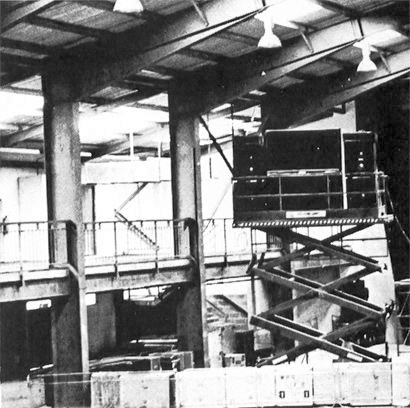
The left-hand side of the P.A.
By 2 a.m., the stage had been cleared and the gear loaded into two trucks. The crew headed back to the hotel, happy with the two gigs. A meal awaited the workers when we arrived back at the hotel, and eight of us sat up until 6 a.m. discussing the gigs, the excellent sound system and The Who. As the sun came up, everyone headed for bed looking forward to a day off before travelling on to Manchester for the next two gigs. The general feeling was one of complete satisfaction in a job well done. The crew were pleased, the audience were pleased and, perhaps most important. The Who were pleased with the first part of their 1975 British Tour.
Details of the Marshall Equipment Hire sound system employed by The Who at Stafford:
- 4 x Showco long-throw bass bins
- 8 x JBL 4560 1 x 15″ bass bins
- 4 x Roy Clair 2x12″ mid-range cabs
- 8 x JBL 4550 2x15″ bass bins
- 12 x JBL 2350/2482 mid-range radial horns
- 8 x JBL 2395/2482 mid-range lens units
- 4 x JBL 2356/2440 mid-range/long range radial horns
- 12 x JBL 2345/2420 high-range radial horns
- 24 x JBL 075 high frequency transducers
- 25 x Crown DC300A power amplifiers
